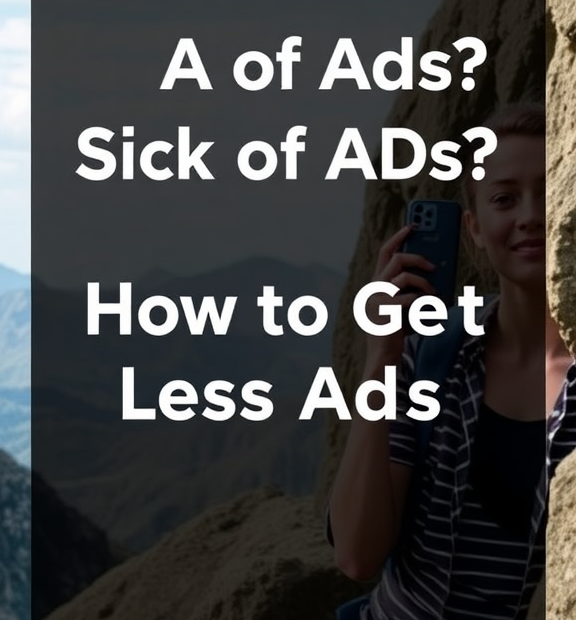Strategies to Reduce Advertisements on Pinterest for a Better User Experience
If you’ve found yourself getting tired of the ads on Pinterest, you’re not alone. As Pinterest grows, so does the number of ads popping up in your feed. However, there are effective strategies you can employ to reduce unwanted advertisements. By following these simple steps, you can enhance your experience and make your Pinterest browsing more enjoyable.
Adjust Your Ad Preferences
One effective way to decrease the number of ads you see is by adjusting your ad preferences. Pinterest allows you to personalize what you would like to see based on your interests and activities. Here’s how to do it:
- Go to your Pinterest profile and click on “Settings.”
- Select “Privacy and data.”
- From here, you can manage your ad preferences, including whether you want to see personalized ads.
By tweaking these settings, you can tailor which ads you see based on your specific interests, or even opt out of certain types of ads entirely.
Engage Less with Ads
Your engagement with ads can directly influence the type and number of ads you see. If you frequently click on ads, Pinterest’s algorithm may take this as a signal that you want to see more advertisements of that nature. To counteract this:
- Try not to click on ads.
- When you see an ad that does not interest you, click on the three dots and select “Hide this ad.”
- Report any irrelevant ads to signal to Pinterest that they are not appropriate for your interests.
This strategy helps train Pinterest’s algorithm to present content that genuinely interests you while reducing the overall number of ads you’ve been seeing.
Utilize Ad Blockers
If you’re looking for a more straightforward approach, consider using an ad blocker. These tools can significantly reduce the number of ads you encounter across various sites, including Pinterest. Download a reputable ad-blocking extension and follow the installation instructions.
While some ad blockers may limit your experience or block legitimate content, you can often customize settings to suit your needs while still enjoying most Pinterest features.
Limit Your Activity on Pinterest
Love what I do? Be a hero and help me keep creating awesome content!
Support My Mission Now!Every donation fuels more great stuff – thank you, legend!
The more active you are on Pinterest, the more data it collects about your interests. If you want to see fewer ads, consider scaling back your activity:
- Log in less frequently.
- Avoid creating multiple boards or saving excessive pins.
- Unfollow boards or users that are less relevant to your current interests.
By limiting your activity, you may notice a reduction in ads related to less relevant content.
Feedback on Ads
Love what I do? Be a hero and help me keep creating awesome content!
Support My Mission Now!Every donation fuels more great stuff – thank you, legend!
Another way to see fewer unwanted ads is to provide feedback actively. If you come across an ad that is not relevant to you:
- Click on the three dots on the corner of the ad.
- Select “I see this ad too often” or “This ad is irrelevant.”
This will help refine the algorithm and improve your personalized experience over time. Pinterest values user feedback, and using it wisely can contribute to a better ad experience.
Frequent Cleanup of Boards and Pins
As your interests change, so should what you pin and follow. Regularly cleaning up your boards can help Pinterest get a better sense of what you are currently interested in:
- Remove pins or boards that no longer represent your interests.
- Evaluate the accounts you follow and unfollow any that no longer resonate with you.
Love what I do? Be a hero and help me keep creating awesome content!
Support My Mission Now!Every donation fuels more great stuff – thank you, legend!
This cleanup signals to Pinterest’s algorithm that you’re interested in different topics, which can lead to a shift in the ads served to you.
By implementing these strategies, you can significantly reduce the number of ads you encounter on Pinterest. Remember, your online preferences define your experience, and taking control of them will lead to a more enjoyable time spent on the platform. With design and functionality tailored to your interests, you can focus on discovering inspiration rather than being bombarded with ads.
Understanding Pinterest’s Algorithm: How Ads Work and Why They Appear
Love what I do? Be a hero and help me keep creating awesome content!
Support My Mission Now!Every donation fuels more great stuff – thank you, legend!
Pinterest is not just a platform for creative inspiration; it also serves as a powerful advertising network. Understanding how Pinterest’s algorithm works can help you navigate the site better and minimize the number of ads you encounter. While some ads may be relevant and beneficial, many users feel overwhelmed by the plethora of promotional content. So, let’s uncover how ads work on Pinterest and why they appear in your feed.
At its core, Pinterest’s algorithm is designed to curate content tailored to your interests. When you use Pinterest, the algorithm observes your interactions, including:
- Your search history
- Pins you save to your boards
- Pins you click on
- The accounts you follow
- Your engagement levels with various pins
Using this data, Pinterest aims to show you visuals that resonate with your individual tastes. This personalization extends to ads. Advertisers on Pinterest are trying to reach specific audiences based on their interests, behaviors, and demographics. The more you interact with content related to a specific niche, the more likely you are to see ads related to that niche.
Why do certain ads keep popping up? They appear due to a combination of factors, including:
- Audience Targeting: Advertisers can target users using specific demographics, keywords, and even interests. If you’ve shown interest in topics like home decor or cooking, you may see related ads frequently.
- Engagement History: The algorithm keeps track of how you engage with ads. If you frequently save or click on a certain type of ad, Pinterest will remember this and present similar ads in the future.
- Pin Quality: Pinterest also considers the quality and creativity of the ads. High-quality images and well-crafted content are prioritized, further shaping what you see in your feed.
So, what can you do if you feel bombarded by ads? Here are several strategies to reduce your ad exposure:
- Update Your Interests: Adjust your interest settings in your Pinterest account. If you no longer want to see ads about a particular topic, remove it from your interests list. This can help the algorithm present content that aligns more closely with your current preferences.
- Engage Selectively: Be mindful of the content you interact with. The more you click, save, or engage with particular types of pins, the more the algorithm believes you want to see similar content—including ads.
- Give Feedback on Ads: Most ads come with options for feedback. If you see an ad that’s irrelevant or uninteresting, utilize the “Hide This Ad” feature. This will signal to Pinterest that you do not wish to see similar ads in the future.
- Clear Your Search History: If you find your searches are too product-focused, clearing your Pinterest search history can help reset the types of content and ads shown to you.
- Limit Your Time on the App: The more time you spend on Pinterest, the more ads you are likely to encounter. If you limit your usage, you can reduce the number of ads you see.
Understanding Pinterest’s algorithm opens your eyes to how user behavior drives ad placement. If you notice that certain ads repeat, it’s likely due to your previous engagements. By being intentional about the content you interact with, you can influence the ads that appear in your feed.
In essence, Pinterest wants to provide a personalized experience. However, it is possible to regain control over what advertisements you see. Take a proactive approach by following these strategies, and you can enjoy a more curated experience that speaks to your true interests without the constant interruptions of unwanted ads.
Whether you’re looking for inspiration, DIY projects, or fashion ideas, understanding how Pinterest’s ad system works can significantly enhance your experience. By reshaping your interactions and preferences, you can create a Pinterest feed that reflects what you truly want to see.
Conclusion
Reducing the number of ads you see on Pinterest can significantly enhance your browsing experience. By implementing strategies such as adjusting your ad preferences, engaging with content that genuinely interests you, and periodically clearing your search history, you can tailor your feed to be more enjoyable and less cluttered. Remember, the more you interact with the pins that resonate with you, the better Pinterest’s algorithm will understand your preferences, showing you fewer irrelevant ads.
Love what I do? Be a hero and help me keep creating awesome content!
Support My Mission Now!Every donation fuels more great stuff – thank you, legend!
Understanding how Pinterest’s algorithm operates is crucial for minimizing unwanted advertisements. The algorithm is designed to present ads based on user behavior, interests, and engagement patterns. This means that by focusing on high-quality content and interacting with pins that align with your interests, you can influence the algorithm to prioritize organic content over paid advertisements.
Moreover, being mindful of the boards you follow and the profiles you engage with can refine the types of ads that surface in your feed. If you notice frequent ads that don’t appeal to you, take a moment to assess your interaction patterns and adjust accordingly. Pinterest’s ad system aims to deliver a personalized experience, and your input helps shape what shows up on your screen.
Love what I do? Be a hero and help me keep creating awesome content!
Support My Mission Now!Every donation fuels more great stuff – thank you, legend!
By taking these steps, the control over your Pinterest experience is in your hands. With a little patience and attention to how you use the platform, you can create a more enjoyable environment that’s aligned with your personal interests and goals, all while minimizing the distractions that come with excessive advertising.

